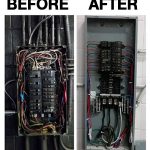 Have you been hearing a humming noise originating from your property’s electrical panel? If so, you’re right to be worried. Your home’s electrical system is designed to operate quietly so you can receive electricity without a hassle or disturbance. The electrical panel controls the power being sent to your home while protecting you from potential hazards.
Have you been hearing a humming noise originating from your property’s electrical panel? If so, you’re right to be worried. Your home’s electrical system is designed to operate quietly so you can receive electricity without a hassle or disturbance. The electrical panel controls the power being sent to your home while protecting you from potential hazards.
So, any unusual sounds will give you concern. This could be a sign that you’re dealing with a serious problem and you’ll want to remedy that issue as soon as possible. What could the noise be? You’ll find out below.
Subtle Buzzing
Do you hear a subtle buzzing sound? Is it faint and tough to hear until you get closer to the panel? The buzzing noise may not be noticeable at all times. And, it likely won’t keep you awake at night. The currents flow through the breakers like water in a stream. So, you’re likely going to hear a faint buzzing sound when getting close to your electrical panel. This may be normal and it might not be anything to worry about. If the noise gets loud, you may have something to worry about. Don’t wait to call an electrician.
Moderate Humming Noises
Is the noise a bit louder? Does it sound like a moderate hum? You may also hear a sparkling or clicking noise. These sizzling sounds could be a sign that something is wrong with the circuit breaker. The problem could be a handful of things. For instance, you might have a problem with loose or frayed wires. This is very dangerous and could lead to a fatal injury. With this in mind, you cannot risk it. You need to call a professional electrician so they can handle the problem.
Loud, Repetitive Buzzing
In some cases, the noise will be so loud that it’ll keep you up at night. A repetitive buzzing sound will be disturbing and it’ll prevent you from getting a good night’s sleep. What causes this to happen? Ultimately, it could be a number of problems. However, the most common issue is that the breaker should be tripping but it isn’t. This tells you that the breaker is bad. Your breaker should trip and shut down the power supply to your home when there is a power surge. This protects your home and prevents additional problems.
If the breaker isn’t working, the current will continue flowing to the wires in your home. This will cause heat accumulation and a scarily loud buzzing sound. This is a sign that you’re dealing with a serious problem. It is a problem that you cannot afford to ignore.
Is The Buzzing Sound Normal?
Electrical panels tend to make buzzing sounds. Sometimes, this will be normal. You may hear a buzz when your AC turns on. It should stop a short time later. However, you should be worried if the humming sound is repetitive and unusually loud.
You need to fix the problem rapidly but you cannot fix it alone. Working on such projects can be dangerous so it is best to hire a professional.
this post first appeared on H&A Long Island Electrician at https://toplongislandelectrician.com/long-island-electrician/electrical-panel-humming-noise/

 In the process of updating your residential electrical system? If so, an important component you will soon encounter is the Federal Pacific Electric (FPE) Panel. This component plays a major role in keeping a home safe when utilizing electricity. When the FPE panel reaches 20 years old, it is time to start contemplating an update. Fortunately, these components are not very complex or expensive. But, they must be replaced by a licensed electrician. How much does an FPE panel replacement cost? Find the answer to this question and more in the article below.
In the process of updating your residential electrical system? If so, an important component you will soon encounter is the Federal Pacific Electric (FPE) Panel. This component plays a major role in keeping a home safe when utilizing electricity. When the FPE panel reaches 20 years old, it is time to start contemplating an update. Fortunately, these components are not very complex or expensive. But, they must be replaced by a licensed electrician. How much does an FPE panel replacement cost? Find the answer to this question and more in the article below. Just several months ago in January, Tesla unveiled its 3rd generation wall connector. People that were already utilizing the 2nd generation are likely somewhat familiar with these products and everything that they have to offer the modern homeowner. In fact, if you are currently utilizing a 2nd generation wall connector, you might find yourself wondering why people are making the costly upgrade to the 3rd generation. Don’t they pretty much do the same thing? Isn’t this just a beefed-up model on the previous generation? Well, let’s take a look.
Just several months ago in January, Tesla unveiled its 3rd generation wall connector. People that were already utilizing the 2nd generation are likely somewhat familiar with these products and everything that they have to offer the modern homeowner. In fact, if you are currently utilizing a 2nd generation wall connector, you might find yourself wondering why people are making the costly upgrade to the 3rd generation. Don’t they pretty much do the same thing? Isn’t this just a beefed-up model on the previous generation? Well, let’s take a look.